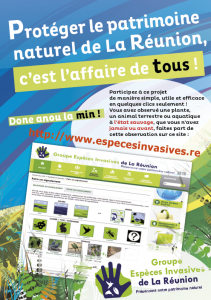Les espèces exotiques envahissantes
On La Réunion island, 30% of the original habitats are still present (Strasberg et al., 2005), compared to the less than 5% in Mauritius and 0% on Rodrigues Island (Lorence & Sussman 1986, 1988). Today, most of them is protected particularly the flora and fauna present in the heart of La Réunion National Park.
The most dangerous threat to these natural ecosystems are Invasive Alien Species.
Since the arrival of man on La Réunion during the 17th century, a considerable number of species has been introduced. A thousand of them have been naturalized (naturally grow in the wild), while it had taken millions of years for nature to do the same … Man has therefore multiplied by a 10,000 fold the rhythm of incorporation of new plants in the ecosystems of La Réunion, which results in jeopardizing their fragile equilibrium!
Among these species, some adapt in a common way and consequently do not pose a threat to the natural habitats and native species, for example in la flora category, there are plants like litchi, Le Flamboyant, banana trees. On the other hand, others have become invasive and critical for the ecosystems of La Réunion. The most problematic species in the semi-dry environment are le “Raison Marron” (Rubus alceifolius), Le “Galabert“ (Lantana camara), la “Baie Rose” (Schinus terebenthifolius), la “Liane Papillon” (Hiptage benghalensis), le “Choca Vert” (Furcraea foetida) ,le “Zavocat Marron” (Litsea glutinosa), le “Faux Poivrier Blanc” (Rhus longipes), le “Zepinard” (Acacia farnesiana) or le “Cassie“ (Leucaena leucocephala).
These are known as exotic plants. They compete with native species which eventually disappear when they cannot cope anymore with the saturation of resources. Moreover, animals whose survival depends on these native species are also threatened. This can be ilustrated by the example of the Salamis augustina (Salamis augustina), an endemic butterfly of La Réunion whose host plant, le ‘Bois d’Ortie’ (Obetia ficifolia) has become extremely rare in the natural state.
In la fauna category, the most problematic animal plague is the rat (Ratus ratus), the ‘Bubul Orphée’ (Pycnonotus jocosus), the ‘Chat haret‘ (Felis catus) and the ‘Agame des Colons’ (Agama agama). The ‘Achetine’ (Achatina fulica) is also a species of concern. This snail consumes on the juvenile plants of the ‘Bois d’Ortie’ (Obetia ficifolia) which results in its decline which consequently triggers that of the Salamide Augustina, the endemic butterfly.

Here are some figures on Invasive Alien Species in La Réunion :
– 15 terrestrial mammals were introduced (9 invasive species)
– 23 bird species (4 invasive species)
– 11 freshwater fishes (4 invasive species).
Why are islands more vulnerable to invasive alien species ?
This is the case as oceanic islands are geographically isolated, small in size and of recent geological age. In addition, they have relatively complex ecosystems.
Learn more about it in the complete french document
Strategy to fight against biological invasion :
On La Réunion, the awareness of the negative impact of Invasive Alien Species sprung by scientists (Cadet 1977, Lavergne 1978) and then by nature conservation managers and decision-makers led to the rise of a strong political will in the early 80‘s to tackle those pests.
Learn more about it in the french document.
A group of professionals have met together to effectively combat these invasive species :
The GEIR (Groupe d’Espèces Invasives de la Réunion) is a framework which deals with Invasive Species on La Réunion.
The GEIR favors the coordination of local actors in planning and implementing a specific strategy to fight against Invasive Species on La Réunion within its scheme for the Operational Programof the eradication of Invasive Alien Species.
Get more information on the GEIR website.




 Français
Français In Progress
In Progress